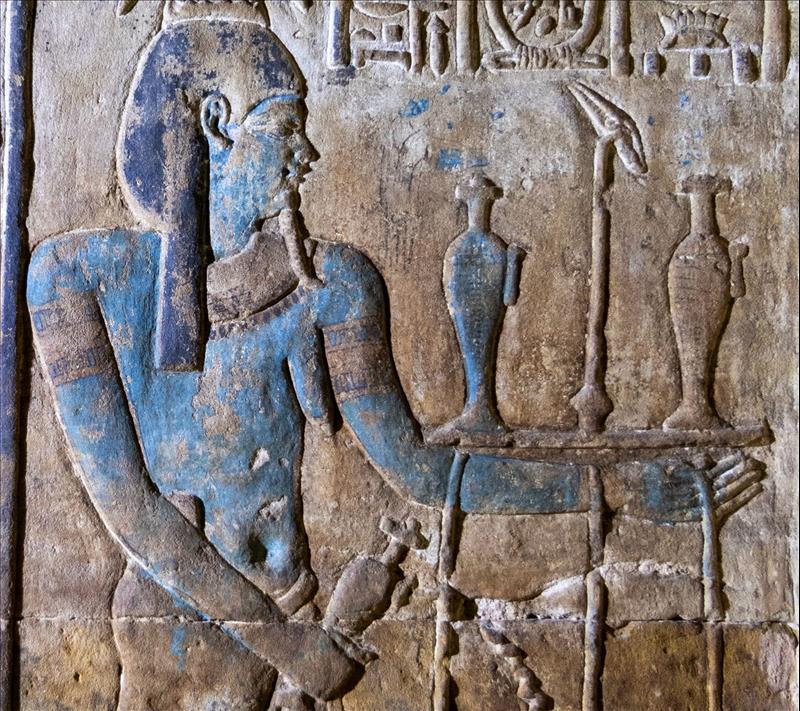
Restoration Project At Edfu Temple Reveals Original Coloured Inscriptions For First Time
This discovery was made during the restoration project of the temple's surface, dedicated to the worship of the god Horus. The project, which began in 2021, is funded by the Gerda Henkel Foundation from Germany.
Minister of Tourism and Antiquities Sherif Fathy praised the efforts of the restorers, particularly the Egyptians, for their vital role in preserving Egypt's cultural heritage. He acknowledged their remarkable work and relentless efforts to reveal and restore the inscriptions on Egyptian temples and recover the original colours that adorned them thousands of years ago.
The minister highlighted the need to expedite the completion of the restoration work in preparation for the winter tourist season and to welcome visitors from around the world.
Secretary-General of the Supreme Council of Antiquities Mohamed Ismail Khaled explained that the temple restoration project aims to clean the temple walls, and restore and document the texts and scenes digitally in new editions with more accurate translations and studies than those published in the last century. The project also includes the restoration and cleaning of the shrines and internal walls of the temple, stabilizing the colours, removing soot, and conducting detailed studies of the texts and scenes on the walls of the Holy of Holies and adjacent rooms.
Khaled noted that during the restoration of the ceiling and walls of the holy of holies in the temple, remnants of colourful scenes and inscriptions by priests written in demotic script were uncovered. Additionally, traces of gold were found, which were used to gild prominent inscriptions, such as royal jewellery, insignia, and the bodies of deities.
For his part, Head of the Egyptian Antiquities Sector at the Supreme Council of Antiquities Ayman Ashmawy mentioned that the texts in the temple indicate that some of its buildings were covered with thick metal foil layers made of gilded copper, of which only remnants of holes in the walls remain. This has led to a lack of documentation in archaeological records.
He highlighted that the Egyptian-German team successfully uncovered this type of gilding in several locations on the upper parts of the walls of the temple's sacred boat chamber.
The project leader and Head of the Egyptology Department at Julius-Maximilians-University Würzburg Martin A. Stadel, stated that the quality of the colours in the temple reflects the advanced state of Egyptian art.
He noted the discovery of a demotic text, written in ink, that had been completely hidden under deposits. This text discusses the entry of priests into the Holy of Holies, a unique inscription since personal writings are typically found in the outer parts of the temple or at entrances, not in the main chamber or the Holy of Holies where the sacred boat and the deity statue are located.
He disclosed that these newly discovered texts would contribute to forming new insights into the religious practices of priests at that time.
The project manager and researcher at Julius-Maximilians-University, Würzburg Victoria Altmann-Wendling, stated that uncovering the original colours of the inscriptions has significantly contributed to understanding more details of the scenes and hieroglyphic writings that were not visible in the prominent inscriptions. It also adds a unique character to the holy of holies, especially when sunlight enters it.
The Horus Temple at Edfu is one of the best-preserved temples in Egypt, featuring a collection of inscriptions and artworks that record important information about the ancient Egyptian language, myths, religious beliefs, and worship practices. It is the second-largest of the ancient Egyptian temples.
Construction of the temple began during the reign of King Ptolemy III Euergetes and was completed during the reign of King Ptolemy XII. The building is a unique monument of ancient religion and architecture, with vibrant and striking colours that have a special charm.

Legal Disclaimer:
MENAFN provides the
information “as is” without warranty of any kind. We do not accept
any responsibility or liability for the accuracy, content, images,
videos, licenses, completeness, legality, or reliability of the information
contained in this article. If you have any complaints or copyright
issues related to this article, kindly contact the provider above.


















Comments
No comment